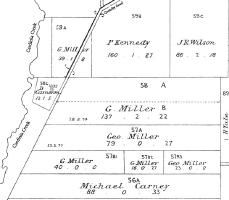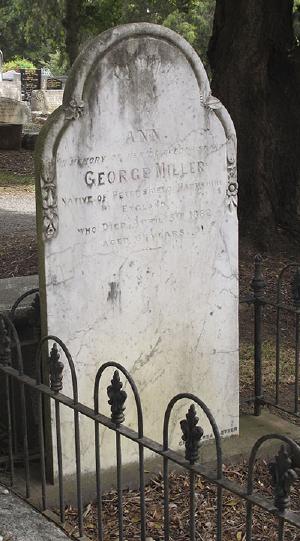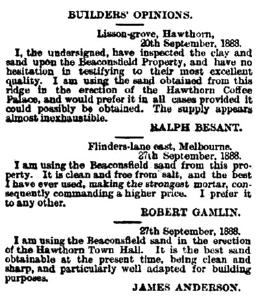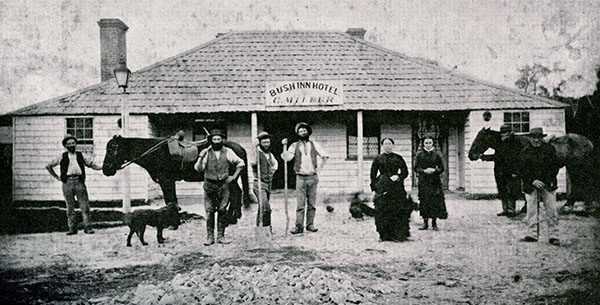
Early history of the Cardinia Park Hotel
George Miller selected his first allotment along the "Cardinia straight" near Quamby road in 1872. It measured 40 acres and was part of crown allotment 59 in the Parish of Pakenham, designated 59A. Initially the mining department objected to the selection because the land was likely to be auriferous - abutting Cardinia Creek. Over the following years Miller added more land to his selection, namely crown allotments 57 A&B and 58 A&B. His total land holding amounted to 335 acres.
At the time of the first selection Miller, born in Hampshire, England was 56 years old, and had been married for about ten years to Ann Somers, born in County Wicklow in Ireland. Ann arrived in Victoria, en route from the United States, and was twenty years younger than him. They did not have any children.
The Leader newspaper reported on 2 March 1872 that George Miller had been successfully growing hops on his property for three years on a section he had cleared of tea-tree. He had built hop houses for drying the crop. His enterprise was not carried on beyond his days. In 1872 Miller, Charles Souter and William Dalton, were appointed to the committee of management of the land set apart for cricket and general recreation purposes near the cemetery at Berwick. Miller also built the "Bush Inn Hotel" finishing shortly before 1878. It was a weatherboard building, containing ten rooms, lathed and plastered inside, in the same location or close by the present Cardinia Park Hotel. Why he built a hotel there is not clear as it was only a short way from Souter's Gippsland Hotel on the Gippsland road at Beaconsfield, and the Inglis Road bridge over the Cardinia Creek was not yet built. His hotel was probably a destination or stopping point for itinerant workers. It was never advertised, and holidaying guests were more likely to spend time at the Upper Beaconsfield guesthouses. However, in November 1878, he advertised 100,000 tons of firewood for sale - an advertising ploy or typesetting mistake probably.
Only two years later in October 1880, the hotel and most of his land was advertised for auction, followed by a clearing sale, including 40 head of cattle, three horses, pigs and poultry, as well as tools. It turns out that Miller was close to insolvency, and as no buyer for his property came forward, Miller's estate was placed under administration on 1 December 1880. Samuel H Cohen was assigned to his estate. The reasons for the insolvency were a fall-off in business, and the collapse of the Provincial and Suburban Bank, where he had shares. Although his books showed a surplus of £1,000, S H Cohen, advertised the stock-in-trade, furniture, firewood and some livestock for auction in 15 December 1880. It seems like the hotel may have been shut for some time, as on 28 February 1881 it was again put up for auction with the note that an industrious and painstaking landlord could do well given its first-class position on the road.
The successful bidder at the auction was David Boyd, an estate agent of South Melbourne. He was later known as the owner of Sandown Park racecourse. The Millers endured at the location and may have continued running the inn/hotel for the new owner.
During 1881 the Department for Lands was lobbied for a bridge over Cardinia Creek 'at Miller's' (its present position), and it was decided that the department would pay £200 if council put in £225.
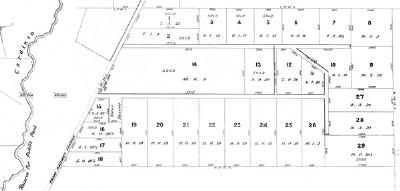
On 5 April 1882, George Miller suffered a stroke and died suddenly. He was buried in Berwick Cemetery, and Ann had a headstone erected on the grave, "in memory of her beloved husband".
On 11 May 1883 David Boyd sold the 40-acre allotment the Bush Inn Hotel was on to no other than Ann Miller. She had applied for a publican's licence after George's death, and was granted such at the yearly meeting of the licensing board in late 1882. Women were granted licenses in their own name, as they were keeping a 'public house'. Two years after George's death Ann Miller married John Milne, a widower with five children, who had selected land along Quamby Road in 1879. It's not clear if he lived there. He hailed from Aberdeen in Scotland.
Boyd decided to sell all his interests in his previous purchase by sub-dividing the land into 20 smaller blocks, which were advertised for auction in February 1885. On the sale poster a number of blocks were marked as sold, and it turns out that they were transferred to Ann Milne on 10 September 1886. On the same day, the balance of the property went to John Milne, meaning none of the other smaller blocks were sold. The subdivision was never formally affirmed by the lands department. Crown allotment 59A was sold to William Fuller.
Ann Milne continued to operate the Bush Inn Hotel with the help of John. In June 1887 John was prosecuted and fined for serving liquor to patrons who were not lodgers on a Sunday. The patrons he served were two constables! He was fined £5 and costs. In October 1887, a further similar breach saw him fined £10.
This bad publicity was countered, in July 1887 by a reporter of the South Bourke and Mornington Journal who made an advertorial 'trip to Beaconsfield'. The new brick 'Cardinia Park Hotel', replacing the Bush Inn Hotel was complete, (bar a half-finished billiard room) and contained 14 rooms. Every compliment a reporter could bestow on the new premises, its facilities, its location and civility of the proprietors was duly reported. Even carvings of hops in the stain glass windows, to remember Ann's late husband George Miller, were mentioned, even though the hops buildings were mentioned as being in decline. A visit to the brick works, that John distributed from was also added to the article.
An ad the following week in the paper, begging to inform local residents that John had rebuilt the hotel appeared. The nearby brickyard was mentioned as well as sales of sand and tiles, to people desirous of building villa residences.
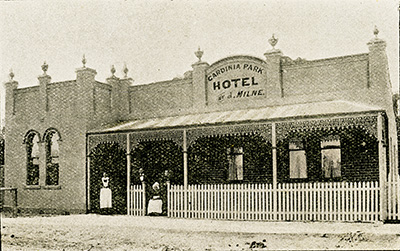
After just establishing things, on 3 November 1888 both Ann and John Milne sold their respective land holdings to Dr John Holden Webb, a surgeon, and Hon Dr Louis Lawrence Smith, a medical practitioner, businessman and MLA, who already had substantial interests in the area.
Why did these two medics buy this land? An advertisement taken out by William Brisbane, a notorious land dealer and then also employed by LL Smith as his personal secretary, may shed some light.
A land boom was on, and Brisbane - on behalf of the soon to be formed Beaconsfield Heights Estate Company - had signed an agreement with Smith and Webb on 19 September 1888 to buy their land. As properties in the vicinity had changed hands for considerable sums, the venture was sure to be a winner! The revenue of the company was to be the sale of the residential sites, and commercial returns of the sale of firewood, sand interests, the manufacture of bricks, and the revenue from the hotel. The advertisement included great testimonials as to the quality of the sand and clay that was available. However, before the company was incorporated, in a now familiar move, the title for the hotel with 5 1/2 acres of land was sold back to John and Ann Milne.
Some investors signed up to the Beaconsfield Heights Estate Company and 17,292 of the 20,000 shares were subscribed to, though not fully paid up. William Brisbane held about 4000 of them. It appears that no land was sold, and both LL Smith and William Brisbane were in financial trouble, as a deep recession soon engulfed Victoria. Smith obtained a mortgage from the Commercial Bank in 1892, with his local land holdings as security. Brisbane went through what would be is second round of insolvency proceedings which amongst other items showed debts to Smith of £2,600 for moneys lent, and £1,730 to the Beaconsfield Heights Estate Company, which was by now in liquidation. As Smith's loans were unsecured, he would have seen little return for them.
Insolvency proceedings were also taken against John Milne during 1892, but there was no report detailing his assets. Milne by now was described as a contractor, and had probably tendered for council contracts. After he had lost out on a contract, he wrote an insulting letter to Council. Brisbane, at the time a councillor, suggested that Milne be banned from tendering for twelve months. Other councillors were more amiable suggesting a warning, to which Brisbane replied that "Milne [is] anything but a sensitive individual such a caution would have little effect." The Beaconsfield Heights Estate Company also leased its paddocks to Milne's neighbour Duncan Cameron. A police court case ensued where Cameron was suing Milne for destroying fencing and a gate, and grazing his cattle on Cameron's lease, and trespassing. This case was thrown out as the court had no jurisdiction. On the same day Milne's son Alex, sued Cameron's son Hugh for sending Milne's cattle to the pound, despite being offered a trespass payment. On a technicality, Hugh did not have the right to impound the cattle, as he was not the leaseholder, and had refused a trespass payment. He was fined 5s and had to pay court costs.
Just a week later John Milne had a serious accident when a young horse he was driving took fright and capsized the dray which fell on top of him, seriously crushing his chest and inflicting other injuries. His life lingered for about two weeks and John Milne died on 21 November 1892. He was 53 years old. His probate shows that his assets amounted to five pounds at the time of his death.
Ann Milne continued to operate the Cardinia Park Hotel, possibly with the help of John's son. Her widowed mother, Ellen Somers, and her unmarried sister Elizabeth had also moved to Beaconsfield.
After the collapse of the Beaconsfield Heights Estate Company the land, with the exception of the Hotel land was held by The Commercial Bank as the mortgagee. It is not known if anyone leased the land. On 14 Dec 1906 the title was sold to John Payne, of Payne's Bon Marche drapery, clothing and general haberdashery stores. He also bought crown allotments 56A&B closer to Beaconsfield.
Ann Milne transferred her publican's license to Mary O'Callaghan in March 1907, just after she had also sold the hotel property to John Payne. She probably moved to Beaconsfield near the railway station, where she owned property. She died on 26 March 1913, and is buried in the Berwick Cemetery. (Her probate shows that she had done quite well for herself as she owned numerous properties in Berwick and Beaconsfield.)
In 1911 John Payne transferred the property except the hotel to his son, John William, who established a homestead and built a new villa. He then subdivided the land and a large auction sale took place in November 1912. The farm lands failed to find buyers. John Payne snr was reported to have sold the hotel property to a Mr Young for £1,050. The Youngs had previously been at the Pine Grove Hotel. Mary O'Callaghan's lease was naturally not renewed and in April 1913 she held a clearing sale for the complete furnishings of the eight rooms. A few weeks later the licence was transferred to Mrs Fanny Young.
In July 1915 the Dandenong Advertiser reported that Payne was selling his 900 acres that he had converted from wilderness to efficiency, spending nearly £7,000. A large part of this land was later farmed by various members of the Grant family as orchards, largely as soldier settlement blocks.
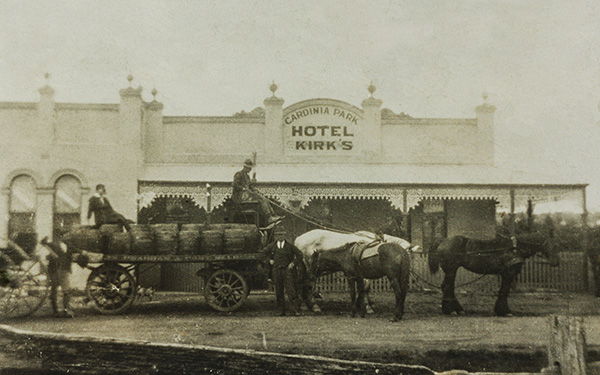
Later owners and licensees
The Youngs probably did not pay off the purchase price for the hotel as in February 1916 the hotel freehold (1 1/4 acres) was transferred from John Payne to Mary Alicia Dineley. Mary Dineley also bought 10 1/2 acres surrounding the hotel, and further 45 acres were jointly bought by Mary and her husband Frederick William Dineley. Mary's son from her previous marriage (Edward Bernard Thual/Dineley) served in WW I and was killed in action in Belgium in 1917. He is remembered at the Beaconsfield War Memorial.
Ownership of the hotel, and its licensees, diverged around this time. In March 1914 the hotel licence is transferred to Josiah Hyde Steele. Up until 1927 he was followed by a long list of mostly short time licensees: Caroline Tulk, Mary Alicia & Frederick William Dineley, Selina Lanigan Oscar, Richard Bayne, Thomas House, Selina Patricia Fettes, Emma Umpherston, Mary Elizabeth Kirk (later at the Pine Grove Hotel), Henry Victor Pickering, Stanley Wilfred Chandler, James Reeves, Mary Ann Tobin, Thomas Charles Warby (who died at the hotel), Annie Jane O'Regan, Eldred Charles Liversidge, Julia Carter, Norman Walker Adamson, Etty Saunders (who stayed for nearly five years), Andrew Cyril Le Brocq, and Edward Randall McMartin.
In 1927 Mary Dineley sold the hotel property and surrounds to Elizabeth Margret Danaher, but stayed in the area for a few more years. Danaher married Eric Arthur Loft, who became the next licensee and hotel owner from 1936 after Elizabeth's death until February 1945.
